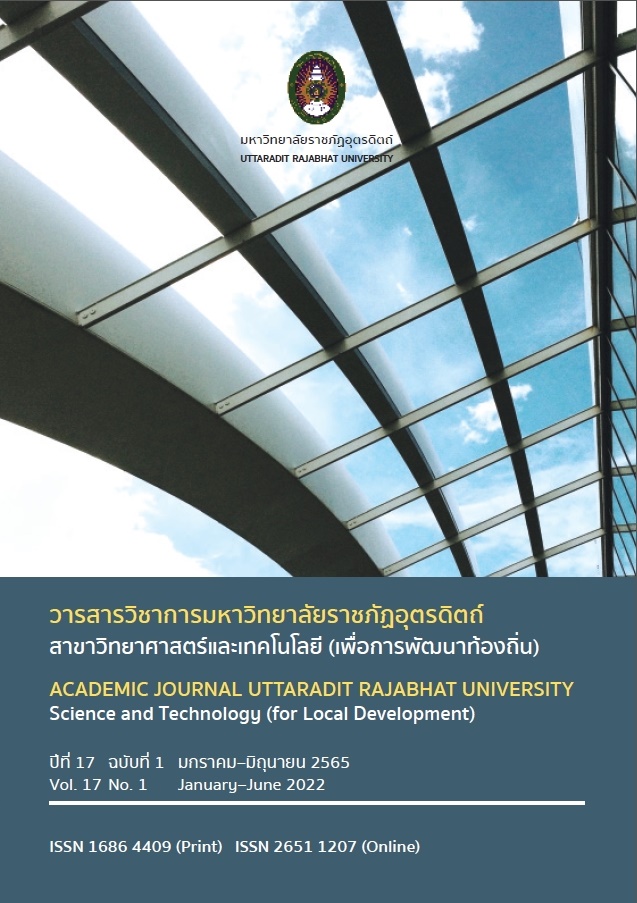UTILIZATION OF WASTE MATERIALS FROM COCONUT TO PRODUCTION OF CONCRETE BLOCKS
Main Article Content
Abstract
The purpose of this research was study to find the appropriate ratio for the production of concrete blocks mixed with coconut waste, and study of properties in compression resistance, density and moisture content after 28 days of curing. The production of concrete blocks from 3 mixture ratios in this study set A with ratio of portland cement type I: sand:rock:coconut wastes 0 percentages as 700:2,100:3,500:0 by weight (g), set B with ratio of coconut wastes 5 percentages as 700:2,100:3,325:175 weights (g) and set C with ratio of coconut wastes 15 percentages as 700:2,100:3,150:350 weights (g), by using wooden formwork 15 x 15 x 15 cm3. Then it was analyzed by compression machines, density, moisture content of concrete blocks, mean and percentage. The results showed that the optimum of appropriate ratio with concrete blocks from coconut waste in this study is set B, if increasing the use of coconut wastes as an ingredient in concrete blocks results in a decrease in compressive strength. The coconut wastes mixture in the ratio of 0, 5 and 15 percentages had average compressive strength of 16.90, 6.45 and 1.67 MPa. The mixture of coconut waste 0 percentages and 5 percentages passed to the TIS-58-2533 standard. For the density test, it was found that adding more coconut waste would decrease the density. As with the moisture content, it was found that the adding more coconut waste would decrease the moisture too. From using the coconut waste in this study can help reduce the problem of waste and create value in production of concrete block for the community.
Downloads
Article Details

This work is licensed under a Creative Commons Attribution-NonCommercial-NoDerivatives 4.0 International License.
References
จักกฤษณ์ พนาลี, พันธ์ศักดิ์ พ่วงพงษ์, และ ธีรภัทร์ รอดคลองตัน. (2559). การศึกษาและออกแบบเฟอร์นิเจอร์สำนั กงานจากเส้นใยกาบมะพร้าว. รมยสาร, 14(ฉบับพิเศษ), 165–172.
จิรวัฒน์ วิมุตติสุขวิริยา. (2555). คุณสมบัติการต้านแรงอัดของคอนกรีตผสมกากใยอ้อยในพื้นที่จังหวัดบุรีรัมย์. บุรีรัมย์: มหาวิทยาลัยราชภัฏบุรีรัมย์.
ณคนัท รักษารักษ์, ธเนศ รัตนวิไล, และ ชัยณรงค์ ศรีวะบุตร. (2562). ผลของเส้นใยเหลือใช้จากเศษวัสดุทางการเกษตรต่อสมบัติเชิงกล สมบัติทางกายภาพ และสมบัติทางความร้อนของวัสดุไม้ผสมพลาสติกจากพอลิโพรพีลีน. วารสารวิจัยและพัฒนา มจธ., 42(4), 327–338.
นันทชัย ชูศิลป์, ชนาภัทร คุ้มภัย, ชาญณรงค์ ศรีแปลก, และ วิไล สิตพงศ์. (2556). สมบัติเชิงกลของซีเมนต์เพสต์เสริมเส้นใยตาลโตนด. วารสารการพัฒนาชุมชนและคุณภาพชีวิต, 1(2), 89–99.
สำนักงานมาตรฐานผลิตภัณฑ์อุตสาหกรรม. (2561). หลักเกณฑ์เฉพาะในการตรวจสอบเพื่อการอนุญาต สำหรับผลิตภัณฑ์คอนกรีตบล็อกไม่รับนํ้าหนัก มาตรฐานเลขที่ มอก. 58-2533. สืบค้น 29 กันยายน 2564, จาก http://law.industry.go.th/laws/file/60509
ปิยะพล สีหาบุตร, เพ็ญชาย เวียงใต้, ภคพล ช่างยันต์, และ เจษฏ์ศิริ เถื่อนมูลละ. (2558). การใช้ฟางข้าวในอิฐบล็อกประสาน. วารสารวิทยาศาสตร์และเทคโนโลยี มหาวิทยาลัยมหาสารคาม, 36(4), 478–485.
พงศธร กองแก้ว และ ธานินทร์ รัชโพธิ์. (2558). การศึกษาสมบัติเชิงกลและเชิงกายภาพของพลาสติกเสริมแรงด้วยใยกาบกล้วยนํ้าว้าและใยมะพร้าว. มหาสารคาม: มหาวิทยาลัยราชภัฏมหาสารคาม.
ภูษิต เลิศวัฒนารักษ์ และ อัญชิสา สันติจิตโต. (2555). คุณสมบัติของวัสดุไฟเบอร์ซีเมนต์ผสมเส้นใยธรรมชาติจากเส้นใยมะพร้าวและเส้นใยปาล์มเพื่อผลิตวัสดุก่อสร้าง. Journal of Architectural/Planning Research and Studies, 9(1), 113–124.
ศักดิ์สิทธิ์ ศรีแสง. (2550). คอนกรีตผสมใยมะพร้าว. วิทยานิพนธ์ สาขาอุตสาหกรรมศึกษา คณะศึกษาศาสตร์ มหาวิทยาลัยศรีนครินทรวิโรฒ.
สมพงษ์ พิริยายนต์ และ กิตติศักดิ์ บัวศรี. (2562). การผลิตและทดสอบสมบัติทางความร้อนและทางกลของวัสดุผสมจากนํ้ายางธรรมชาติและเส้นใยมะพร้าว. ใน งานประชุมวิชาการระดับชาติ IAMBEST ครั้งที่ 4 (The 4th National Conference on Informatics, Agriculture, Management, Business administration, Engineering, Science and Technology), (น. 684–690). ชุมพร: สถาบันเทคโนโลยีพระจอมเกล้าคุณทหารลาดกระบัง วิทยาเขตชุมพรเขตรอุดมศักดิ์.
สำนักงานพัฒนาวิทยาศาสตร์และเทคโนโลยีแห่งชาติ. (2565). เศรษฐกิจสีเขียว. สืบค้น 20 มกราคม 2565, จาก https://www.bcg.in.th/green-economy/
สุวัฒชัย ปลื้มฤทัย และ โยธิน อึ่งกูล. (2555). การพัฒนาคอนกรีตบล็อกจากผักตบชวา. วิทยานิพนธ์มหาบัณฑิต สาขาสถาปัตยกรรม คณะสถาปัตยกรรมศาสตร์ มหาวิทยาลัยศิลปากร.
Mardiha, M., Nge, Z. Z., Chai, W. J., & Lim, J. L. (2021). Concrete Block with Partial Replacement of Coarse Aggregate by Coconut Shell: A Review. Multidisciplinary Applied Research and Innovation, 2(1), 25–35.
Sanjay, K. V., & Sagar, S. (2019). Use of Coconut Shell as Partly Substitution of Coarse Aggregate – An Experimental Analysis. In American Institute of Physics (AIP) Conference Proceedings 2158, (pp. 020021-1–020021-8). 25 September 2019. Madhya Pradesh: India.
Tomas, U., & Ganiron, Jr. (2013). Sustainable Management of Waste Coconut Shells as Aggregates in Concrete Mixture. Journal of Engineering Science and Technology Review, 6(5), 7–14.
Tomas, U., Ganiron, Jr., Nieves, U. G., & Tommy, U. G. (2017). Recycling of Waste Coconut Shells as Substitute for Aggregates in Mix Proportioning of Concrete Hollow Blocks. World Scientific News, 77(2), 107–123.


